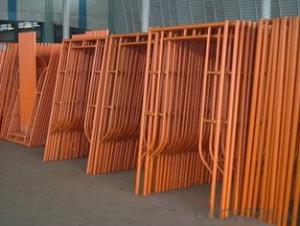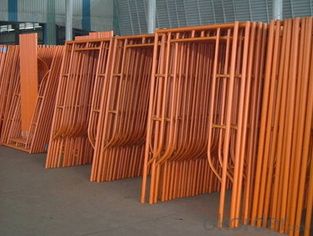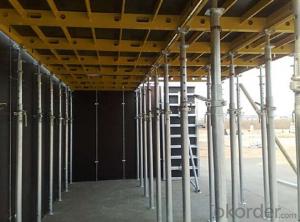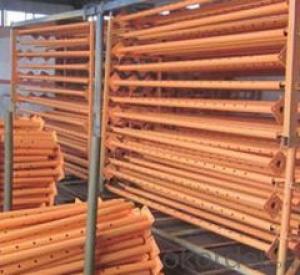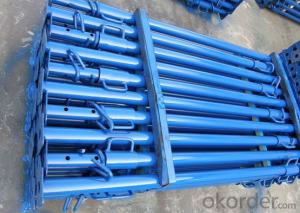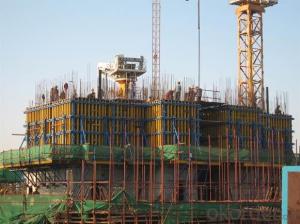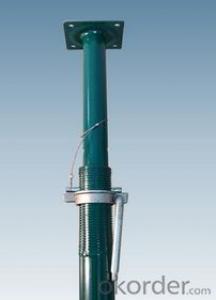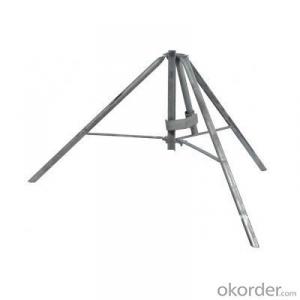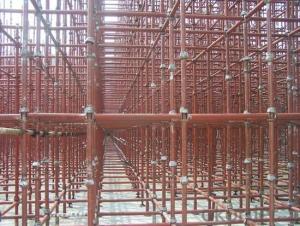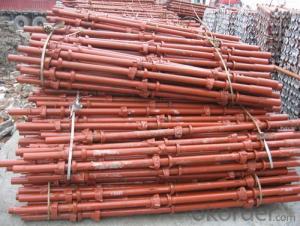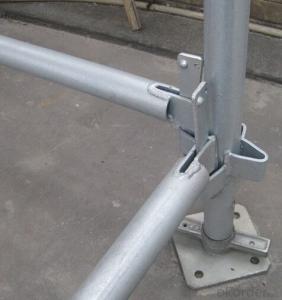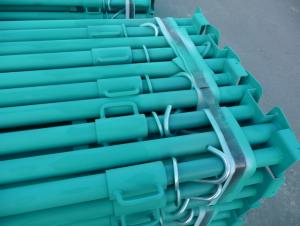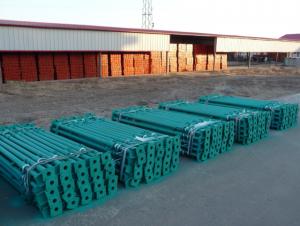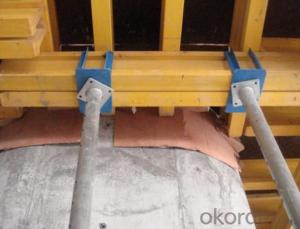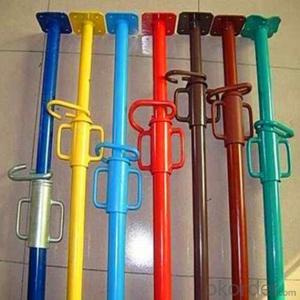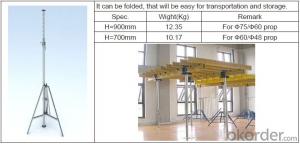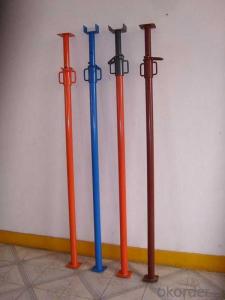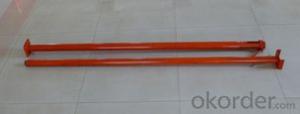Steel Frame Scaffolding H Frame Scaffolding For Sale (Frame Types of Scaffolding)
- Loading Port:
- China Main Port
- Payment Terms:
- TT OR LC
- Min Order Qty:
- -
- Supply Capability:
- -
OKorder Service Pledge
OKorder Financial Service
You Might Also Like
Quick Details
| name: | material: | thickness: | |||
| surface Treament: | standard: |
Packaging & Delivery
| Packaging Detail: | CARTONS THEN ON PALLET,OR AS YOUR REQUEST. |
| Delivery Detail: | WITH IN 25 DAYS |
Specifications
1. Reliable performance
2. Corrosion resistance
3. Durable finish standards
Steel Frame Scaffolding H Frame Scaffolding For Sale
1. Product Information
Product Name | Steel Frame Scaffolding H Frame Scaffolding For Sale |
Type | GTJ-F014 |
Material | Q235 |
Thickness | 1.6mm to3mm or as your requirements |
Surface Treatment | Galvanized, DIP Painting, Powder coated |
color | Customised, normally we make it red(Dark red and Farrari red), yellow, green, blue and silver. |
Dimension | Light duty 40-48mm, MID Duty 48-56/58mm, Heavy duty 48-60mm |
MOQ | 10tons |
Product feature | anti-rust, high breaking strength |
Packaging & Delivery
1.Suitable qty in one carton box
2.Suitable qty packed in plastic bags, then to platte or tray.
3.20 to 25pcs in woven bags
4.20GP can be loaded about 23 to 26 tons
5.deliverying time is about 20days to 30days
- Q: How are steel props transported and stored?
- Steel props are typically transported and stored by stacking them vertically in a secure and organized manner. They are often bundled together and secured with straps for ease of transportation. During storage, they are usually placed in a designated area, either indoors or outdoors, where they are protected from weather elements and potential damage. Additionally, props may be stored on specialized racks or pallets to ensure stability and easy access when needed.
- Q: What are the load testing procedures for steel props?
- The load testing procedures for steel props typically involve applying incremental loads to the prop until it reaches its maximum capacity. The load is usually increased in predetermined increments and held for a specified duration to ensure the prop can withstand the intended load. The prop is visually inspected before and after the test, and any deformations or failures are noted. This process helps determine the maximum load-bearing capacity of the steel prop and ensures its safety and reliability in real-world applications.
- Q: What are the common load distribution methods for steel props?
- The common load distribution methods for steel props include using timber soleplates, steel soleplates, and load-bearing beams. These methods help distribute the load evenly and provide stability to the steel props, ensuring proper support for temporary structures or during construction activities.
- Q: Are steel props suitable for supporting temporary walkways?
- Yes, steel props are suitable for supporting temporary walkways. Steel props, also known as steel shoring or temporary supports, are commonly used in construction projects to provide temporary and adjustable support to various structures, including walkways. Steel props offer high load-bearing capacity and stability, making them ideal for supporting the weight of people walking on temporary walkways. Additionally, steel props can be easily adjusted and secured in place, ensuring the walkway remains stable and safe for use. Overall, steel props are a reliable and suitable option for supporting temporary walkways.
- Q: What are the common sizes of steel props available in the market?
- The market offers a variety of steel prop sizes, which can differ based on the region and construction industry requirements. However, there are a few standard sizes that are commonly found across different markets. One frequently used steel prop size is Size 0, which typically allows for an adjustable height range of 1.75 to 3.12 meters. This size is commonly utilized for lighter loads and situations where a smaller prop is sufficient. Another popular size is Size 1, which generally provides an adjustable height range of 2.0 to 3.5 meters. This size is suitable for medium loads and is commonly employed in various construction projects. For heavier loads and larger construction projects, Size 2 steel props are commonly used. This size usually allows for an adjustable height range of 2.5 to 4.5 meters. Size 2 props are often preferred due to their higher load-bearing capacity and stability. Furthermore, specialized steel props are available in the market to cater to specific requirements. These may include larger sizes or props designed for unique applications like underpinning or formwork support. It is important to note that these sizes may vary slightly depending on the manufacturer and region. Therefore, it is crucial to consult a reputable supplier or manufacturer to determine the specific sizes available in your market.
- Q: What are the common maintenance requirements for steel props?
- Some common maintenance requirements for steel props include regular inspection for signs of damage or wear, cleaning and lubricating moving parts, and ensuring proper storage and handling to prevent rust or corrosion. It is also important to follow manufacturer guidelines for the safe and effective use of steel props.
- Q: Do steel props require any additional support at the base?
- Yes, steel props typically require additional support at the base to ensure stability and prevent any potential movement or collapse. This can be achieved by using a suitable base plate, spreading load-bearing material such as timber sleepers or concrete blocks, or anchoring the props to the ground using stakes or anchors.
- Q: What are the common accessories used for stabilizing steel props?
- The common accessories used for stabilizing steel props include base plates, u-heads, and bracing systems. Base plates are typically used at the bottom of steel props to provide a stable footing and distribute the load evenly. They are often made of steel or other sturdy materials and are designed to prevent the props from sinking into the ground or damaging the surface they are placed on. U-heads are another commonly used accessory for stabilizing steel props. These are attachments that are placed on top of the props to support beams or other structural elements. U-heads typically have a U-shaped design that allows for easy placement and adjustment of the supported load. Bracing systems are also essential for stabilizing steel props, especially in situations where there is a need to support heavy loads or to prevent lateral movement. Bracing systems typically consist of horizontal and diagonal beams that are connected to the steel props and provide additional stability and strength to the structure. In addition to these main accessories, other accessories such as pins, bolts, and clamps may also be used to secure and connect the different components of the steel prop system. These accessories are essential for ensuring the stability and safety of the props and the entire structure they are supporting.
- Q: Span of 40 meters, the height of the beam to support the 1.4 meter high density?
- Building materials used in the field of electrical appliances, new technological breakthroughs in innovation, JDG galvanized steel pipe and thin wall steel pipe jumper wire connection should not use the complex structure of welding and metal conduit,
- Q: Can steel props be used in the construction of temporary medical facilities or field hospitals?
- Temporary medical facilities or field hospitals can utilize steel props for construction purposes. These props, also known as adjustable steel props or scaffolding props, are commonly employed in the construction industry to provide temporary support and stability to structures or formwork. In the context of temporary medical facilities or field hospitals, steel props play a vital role in ensuring structural stability and support for the facility's various components. They can be used to support temporary walls, roofs, or partitions, guaranteeing the structure's safety and integrity. Steel props offer versatility, as they can be easily adjusted to the required height and load-bearing capacity, making them suitable for various construction projects, including temporary medical facilities or field hospitals. These props are designed to withstand heavy loads and provide reliable support, which is crucial for ensuring the safety of medical personnel and patients in these facilities. Furthermore, steel props are lightweight and easily transportable, making them ideal for rapid deployment in emergency situations. They can be quickly assembled and disassembled, facilitating efficient construction and dismantling of temporary medical facilities or field hospitals as needed. In conclusion, steel props are a valuable asset in the construction of temporary medical facilities or field hospitals, providing the necessary support and stability to ensure the safety and functionality of these critical facilities.
Send your message to us
Steel Frame Scaffolding H Frame Scaffolding For Sale (Frame Types of Scaffolding)
- Loading Port:
- China Main Port
- Payment Terms:
- TT OR LC
- Min Order Qty:
- -
- Supply Capability:
- -
OKorder Service Pledge
OKorder Financial Service
Similar products
Hot products
Hot Searches
Related keywords
